How to Ensure Your Cat Feels Safe During Socialization
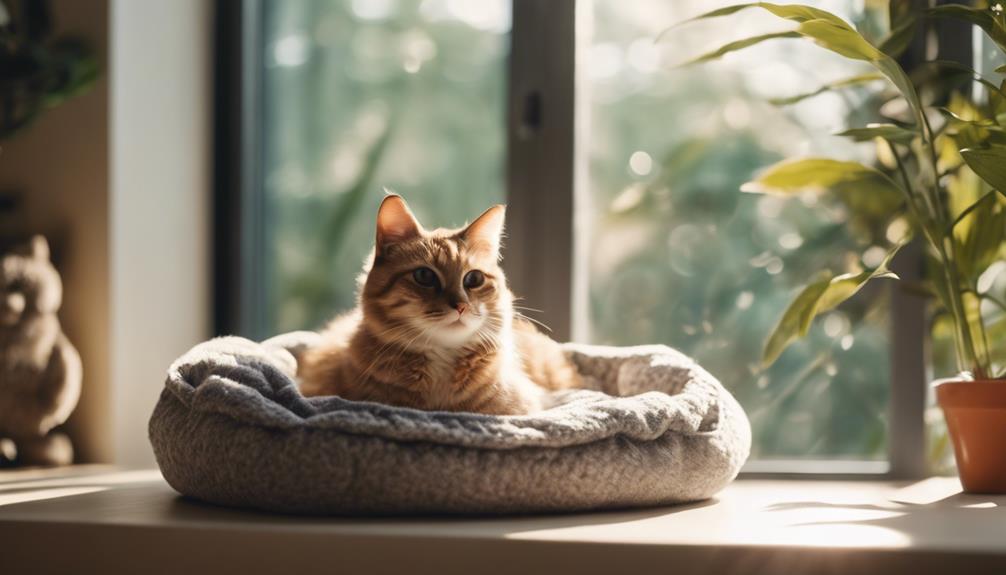
Socializing a cat is important for their well-being and happiness. To ensure your cat feels safe during this process, it's crucial to go at their pace. Start by creating a calm and quiet environment for your cat to feel comfortable in. Provide hiding spots and vertical spaces for them to retreat to if they feel overwhelmed.
Introduce new people and animals slowly, allowing your cat to approach them on their terms. Use positive reinforcement, such as treats and praise, to associate social interactions with good experiences. Pay attention to your cat's body language and behavior, and give them space if they show signs of stress.
Consistency is key when socializing a cat, so try to stick to a routine and provide plenty of opportunities for positive interactions. Remember that socialization is a gradual process, and it's important to be patient and understanding with your cat throughout the journey. With time and patience, your cat can learn to feel safe and secure in various social situations.
Safe Space Setup
Creating a designated safe area for your cat is crucial to ensuring their comfort and security during the socialization process. When setting up a safe space for your feline friend, focus on comfort zone design and stress-free environment. Consider providing safe retreats and cozy corners where your cat can retreat to when feeling overwhelmed. These areas should be equipped with familiar items like their bed, toys, and scratching posts to help them feel secure.
It is essential to choose a quiet location away from high-traffic areas to minimize disturbances. Utilize soft bedding and ensure the space is well-ventilated with access to natural light. To further enhance the comfort of the safe space, consider incorporating soothing elements such as calming pheromone diffusers or classical music playing softly in the background. By creating a safe haven tailored to your cat's needs, you can help them feel more at ease and facilitate a smoother socialization process.
Gradual Introductions
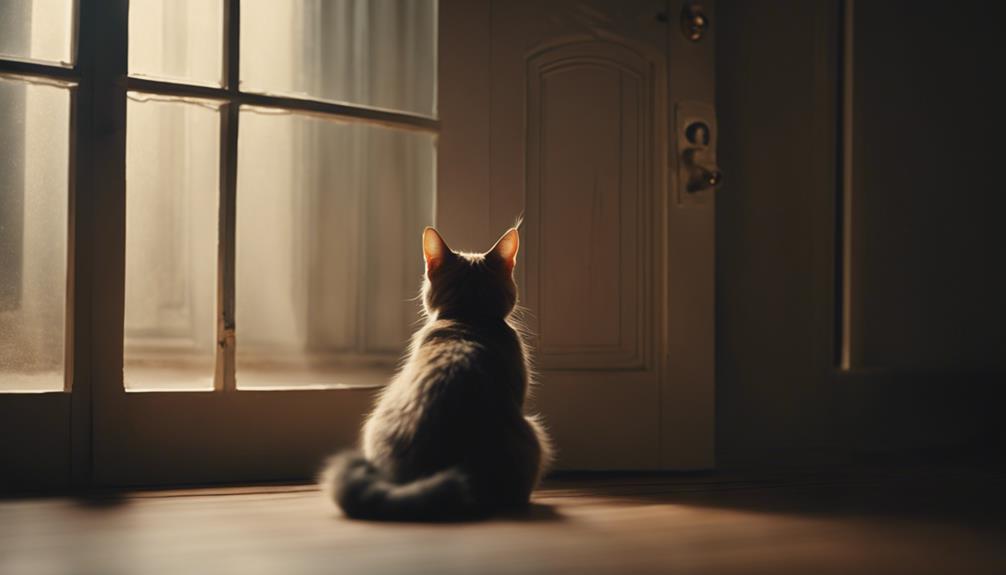
When introducing your cat to new people or animals, it's important to proceed gradually to prevent overwhelming your feline companion. Slow introduction processes and gradual socialization techniques are key to ensuring your cat feels safe during these interactions.
Here are some steps to help you with the process:
- Quiet Environment: Choose a calm and quiet space for the introductions to reduce stress for your cat.
- Short Sessions: Keep the initial meetings brief to prevent your cat from becoming anxious.
- Positive Associations: Use treats and toys to create positive associations with the new individuals or animals.
- Monitor Body Language: Pay attention to your cat's body language for signs of stress or discomfort, and adjust the introductions accordingly.
Positive Reinforcement Training
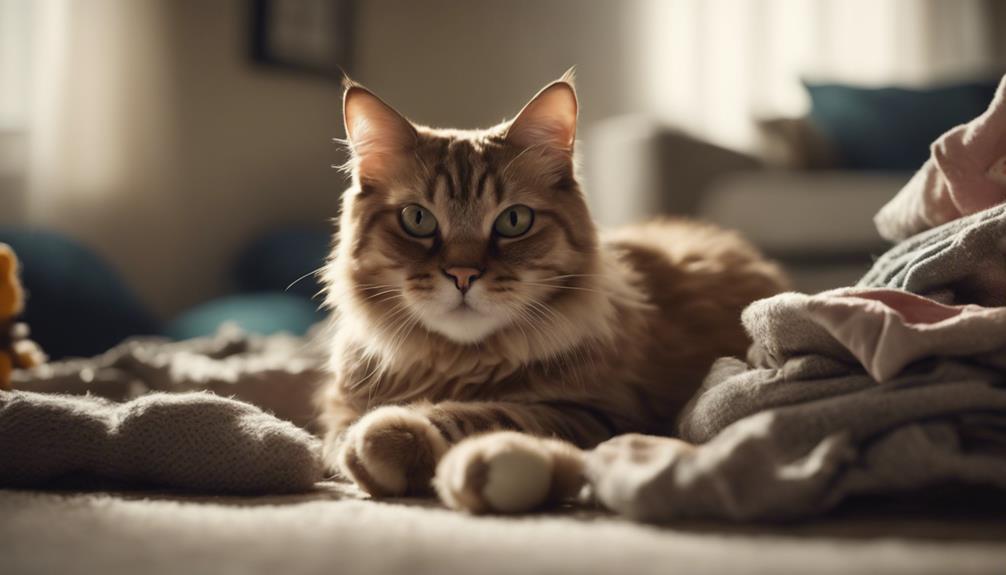
Positive reinforcement training involves rewarding desired behaviors, creating a positive association with socialization.
Consistency in training is key to reinforcing good habits and helping your cat feel secure.
Patience and encouragement are essential in guiding your cat through the socialization process.
Rewarding Desired Behaviors
To reinforce desired behaviors in your cat during socialization, utilize positive reinforcement training techniques. Positive reinforcement helps build trust and strengthens the bond between you and your feline companion.
Here are some tips for rewarding desired behaviors:
- Treats: Use delicious treats to reward your cat when they exhibit positive behaviors.
- Praise: Offer verbal praise in a gentle tone to show your approval.
- Playtime: Engage in play sessions as a form of reward for good behavior.
- Affection: Show your cat love and affection through gentle petting and cuddles when they behave well.
Consistency in Training
Consistency in training your cat using positive reinforcement techniques is crucial for reinforcing good behaviors and fostering a strong relationship. Training consistency is key to successful behavior modification and socialization progress.
By maintaining a regular schedule and providing positive reinforcement for desired behaviors, you can help your cat understand what's expected of them. However, training challenges may arise, requiring patience and persistence. It's essential to stay consistent even when faced with setbacks.
Celebrate small victories along the way to encourage further progress. Remember, building a bond with your cat takes time and effort, but the rewards of a well-socialized and happy feline companion are worth it.
Patience and Encouragement
Transitioning from maintaining a regular training schedule, ensuring your cat's safety during socialization involves demonstrating patience and providing encouragement through positive reinforcement techniques. Building trust and using a gentle approach are crucial elements in helping your cat feel safe and secure.
Here are some key points to consider:
- Create a Safe Environment: Ensure the space is quiet and free from potential stressors.
- Use Treats and Affection: Reward good behavior with treats and gentle petting to reinforce positive interactions.
- Progress at Your Cat's Pace: Allow your cat to set the speed of socialization to prevent overwhelming them.
- Celebrate Small Victories: Acknowledge and praise even the smallest steps towards socialization to encourage further progress.
Monitoring Body Language
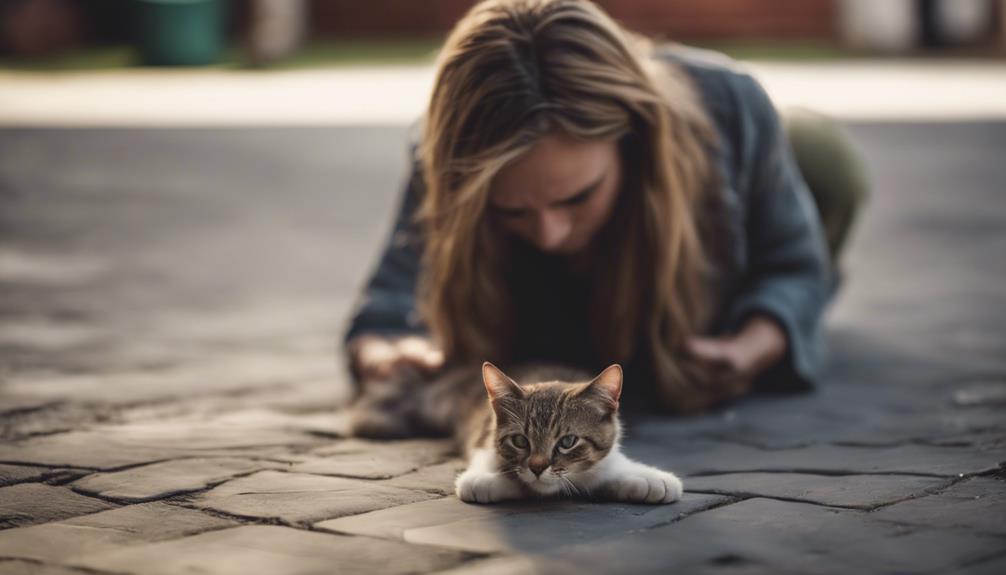
Cats communicate through their body language, offering subtle cues that indicate their comfort level. Recognizing stress signs, such as flattened ears or a flicking tail, is crucial for understanding your cat's emotions during socialization.
Responding promptly to any signs of discomfort can help create a positive socialization experience for your feline friend.
Reading Cat Cues
To ensure your cat's safety during socialization, pay close attention to their body language cues. Cats communicate through subtle cues that can indicate their comfort level and emotions. When reading your cat's cues, consider the following:
- Tail position: A relaxed tail typically indicates a content cat, while an upright or puffed tail may signal agitation.
- Ears: Forward-facing ears show interest or happiness, while flattened ears suggest fear or aggression.
- Eyes: Dilated pupils could mean excitement or stress, while half-closed eyes indicate relaxation.
- Body posture: A cat with an arched back may be feeling threatened, while a relaxed posture signifies comfort.
Recognizing Stress Signs
Recognizing stress signs in cats can be crucial for ensuring their well-being during socialization. Cats may display various stress signals when they feel overwhelmed or frightened. These can include dilated pupils, flattened ears, a twitching tail, or excessive grooming.
It's important to pay attention to these cues to address fear responses promptly. If you notice your cat exhibiting these behaviors, try to create a calm environment by removing any potential stressors. Providing a safe space where your cat can retreat to can help alleviate their anxiety.
Additionally, offering treats or engaging in gentle play can help build positive associations and reduce stress. By recognizing and addressing stress signals, you can help your cat feel more secure and comfortable during the socialization process.
Responding to Discomfort
When observing your cat's body language, it's essential to be attentive to signs of discomfort that may indicate stress or unease. Cats communicate their feelings through subtle cues, and responding promptly can help build trust and a sense of security.
Here are some key points to consider:
- Comforting techniques: Providing a safe space or hiding spot can help your cat feel secure.
- Building trust: Slowly introducing new experiences and people can help reduce anxiety.
- Calming strategies: Using pheromone diffusers or calming music can create a soothing environment.
- Gentle approach: Avoid sudden movements and loud noises to prevent startling your cat.
Providing Hiding Spots
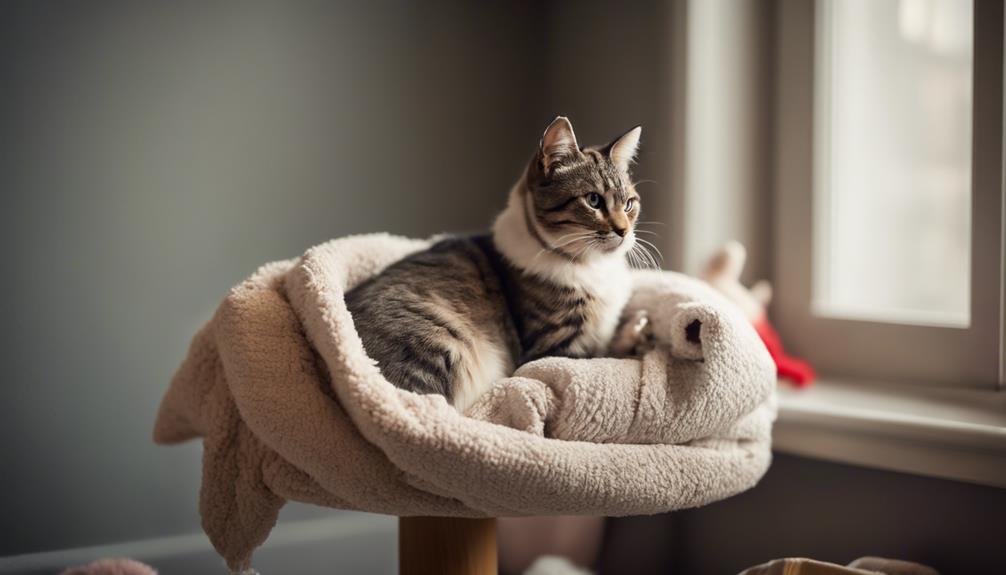
Creating cozy hiding spots in various areas of your home can help your cat feel safe and secure during socialization. Cats often seek comfort zones where they can retreat to when feeling overwhelmed or anxious. Secure spaces provide them with relaxation spots where they can unwind and feel protected. When setting up hiding spots for your cat, consider their preferences – some cats may prefer elevated spots like shelves or cat trees, while others may prefer enclosed spaces like cat caves or covered beds. Placing these hiding spots strategically in quiet areas of your home can give your cat a sense of security while still allowing them to observe their surroundings.
Remember to respect your cat's hiding spots as their safe havens. Avoid disturbing them when they retreat to these areas, as it can disrupt their sense of security. Providing multiple hiding spots gives your cat options to choose from based on their mood and comfort level, ultimately helping them feel more at ease during socialization.
Consistent Routine Establishment
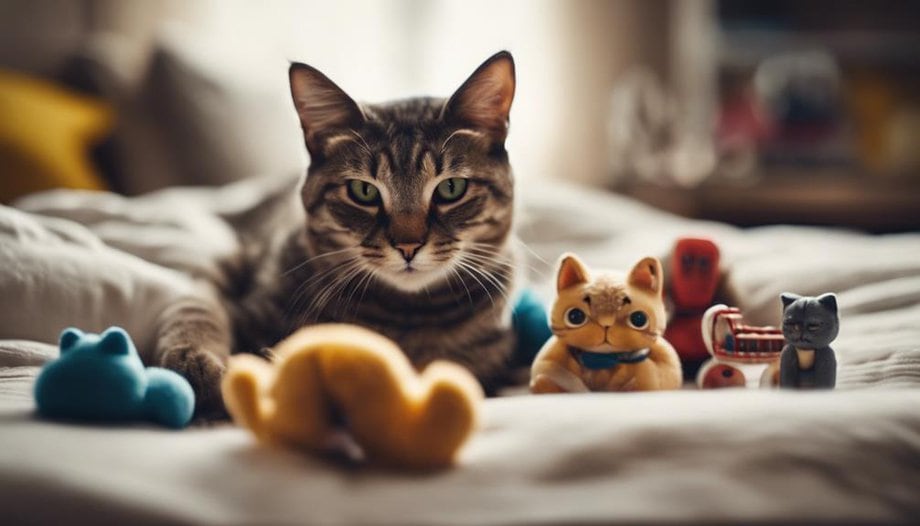
Establishing a consistent routine for your cat is essential for their well-being and comfort during the socialization process. Cats thrive in predictable environments, and having a set schedule can help them feel secure and build trust with their caregivers.
Here are some key points to consider:
- Daily Routines: Feed your cat at the same times each day to create a sense of stability and predictability.
- Comfort Zones: Designate specific areas in your home where your cat can retreat to when they feel overwhelmed or stressed.
- Building Trust: Spend quality time with your cat during consistent play sessions or grooming routines to strengthen your bond.
- Familiar Environment: Introduce new experiences gradually within the framework of their established routine to reduce anxiety and promote a sense of security.
Patience and Understanding
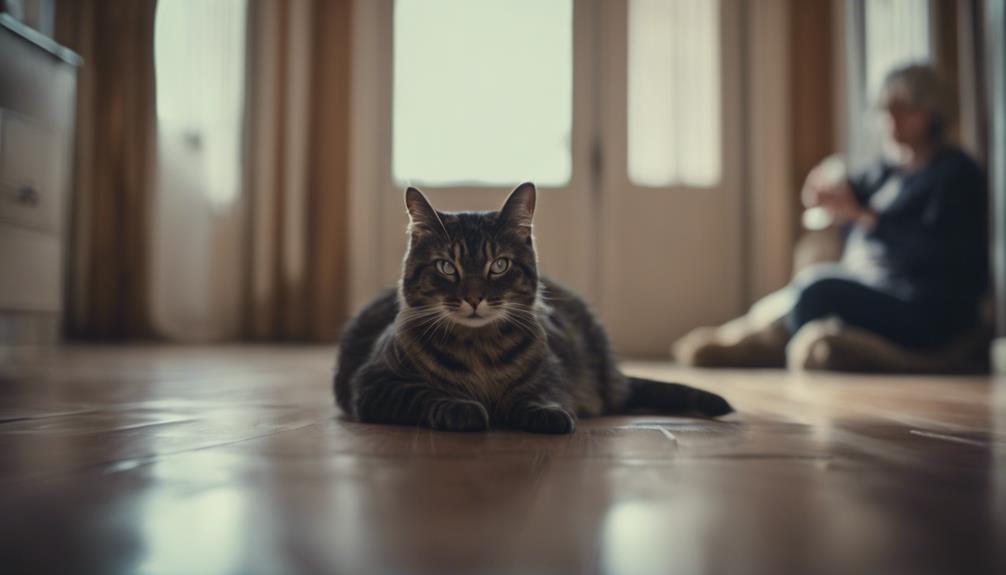
To foster a strong bond with your cat, demonstrating patience and understanding is crucial during the socialization process. Building trust with your feline companion requires a gentle approach that respects their boundaries and allows them to feel safe and secure. It's important to remember that each cat is unique and may require different amounts of time to feel comfortable in new situations.
Patience plays a key role in helping your cat adjust to socialization. Cats can be sensitive to changes and may take longer to adapt to new people, environments, or routines. By allowing your cat the time they need to acclimate, you're showing them that you respect their pace and are there to support them through the process.
Understanding your cat's body language and vocal cues can also help in building trust. Pay attention to how your cat responds to different stimuli and adjust your interactions accordingly. By approaching socialization with patience and empathy, you're laying the foundation for a strong and lasting bond with your feline friend.
Frequently Asked Questions
How Can I Tell if My Cat Is Feeling Overwhelmed During the Socialization Process?
When a cat feels overwhelmed during socialization, their body language might reveal stress signals like flattened ears or dilated pupils. Providing safe spaces and slowly building trust can help them feel more secure and comfortable.
Is It Possible for My Cat to Become Too Reliant on Their Hiding Spot for Comfort?
It's important to consider if a cat is overly reliant on their hiding spot for comfort. Encouraging exploration and gradual exposure, along with bonding exercises and trust building, can help foster a sense of security beyond just one hiding spot.
What Should I Do if My Cat Shows Signs of Aggression Towards Other Animals or People During Socialization?
When a cat shows signs of aggression during socialization, it's crucial to focus on aggression management and behavior modification. Positive reinforcement techniques, along with professional guidance, can help address the issue effectively and ensure a safe environment for all involved.
Are There Any Specific Behaviors or Body Language Cues I Should Watch for to Know if My Cat Is Feeling Comfortable or Uncomfortable?
When observing a cat during socialization, pay close attention to their body language and comfort levels. Signs of comfort include relaxed posture, purring, and slow blinking. Conversely, signs of discomfort may include hissing, flattened ears, and a puffed-up tail.
How Long Does the Socialization Process Typically Take Before My Cat Feels Fully Comfortable in Their New Environment?
The socialization timeline varies for each cat, influenced by their unique experiences. Understanding comfort indicators like body language cues and behavior changes can help gauge progress. Patience, consistency, and positive reinforcement are key during this process.











